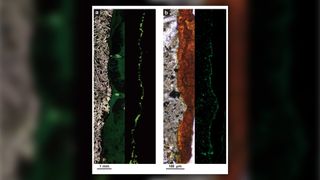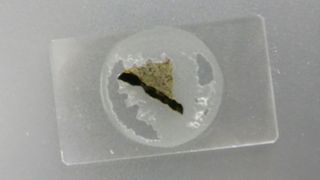Ancient parties of bacteria found thriving deep beneath the South Pacific seafloor
As many as 10 billion microbes live crammed together in tiny crevices.

Deep under the South Pacific seafloor in rocks that are more than 100 million years old, scientists were surprised to find dense colonies of bacteria thriving on crumbs of organic matter.
An estimated 10 billion single-celled organisms occupied just 0.6 cubic inches (1 cubic centimeter) of space in these volcanic rocks; that's about the same bacterial density as that in the human gut, the scientists wrote in a new study.
Because the rock samples were collected far from hydrothermal vents, the bacteria probably weren't randomly carried into the crevices by currents. Rather, they likely colonized the cracks and then multiplied over millions of years, feeding on organic material in the clay that also filled the cracks, the study authors reported.
Related: Beachgoers beware? 5 pathogens that lurk In sand
They collected the bacteria-filled rocks in 2010 from three sites that were 104 million years old, 33.5 million years old and 13.5 million years old, respectively. Researchers dug deep for the samples, extracting cores at depths up to 400 feet (122 meters) beneath the seafloor.
Experts have long suspected that microbes could be found in sub-seafloor rocks, but evidence has remained elusive, said lead study author Yohey Suzuki, an associate professor with the Department of Earth and Planetary Science at the University of Tokyo.
For the new study, Suzuki and his colleagues devised a new method that targeted the tiny cracks in rocks to hunt for single-cell life. Rather than pulverizing their rock samples, as is typically done when searching for signs of life in rocks, the team coated the samples with a special epoxy and then cut very thin slices. This technique is commonly used by pathologists to study thin slices of body tissues; in rocks, the epoxy preserved the shapes of the tiny cracks inside the slices, Suzuki said in a statement.
Sign up for the Live Science daily newsletter now
Get the world’s most fascinating discoveries delivered straight to your inbox.
Then, the scientists stained the slices with fluorescent dye to highlight microbial DNA.

'Greenish signals'
Under a microscope, bacteria in the cracks lit up as glowing green spheres, visible in long, twisting tunnels inside the rocks; chemical analysis confirmed that the "greenish signals" came from microbial DNA and not from fluorescent structures in the minerals. Surrounding the bacteria was fine-grained clay rich in organic carbon, providing vital nutrients for the colonies, according to the study.
Further genetic analysis revealed that there were different bacteria species colonizing rocks that were different ages, perhaps because variations in heat and water flow over millions of years shaped the accumulation of different minerals that fed the bacteria, the researchers reported.
Finding densely packed and thriving microbial communities in this unlikely environment also offers hope for locating microbes that could survive in similar rocky homes on other worlds, such as Mars, Suzuki said in the statement.
"This discovery of life where no one expected it in solid rock below the seafloor may be changing the game for the search for life in space," Suzuki said.
The findings were published online April 2 in the journal Communications Biology.
- 5 ways gut bacteria affect your health
- In photos: The wonders of the deep sea
- Microbiome: 5 surprising facts about the microbes within us
Originally published on Live Science.
OFFER: Save 45% on 'How It Works' 'All About Space' and 'All About History'!
For a limited time, you can take out a digital subscription to any of our best-selling science magazines for just $2.38 per month, or 45% off the standard price for the first three months.

Mindy Weisberger is an editor at Scholastic and a former Live Science channel editor and senior writer. She has reported on general science, covering climate change, paleontology, biology, and space. Mindy studied film at Columbia University; prior to Live Science she produced, wrote and directed media for the American Museum of Natural History in New York City. Her videos about dinosaurs, astrophysics, biodiversity and evolution appear in museums and science centers worldwide, earning awards such as the CINE Golden Eagle and the Communicator Award of Excellence. Her writing has also appeared in Scientific American, The Washington Post and How It Works Magazine.
Most Popular


